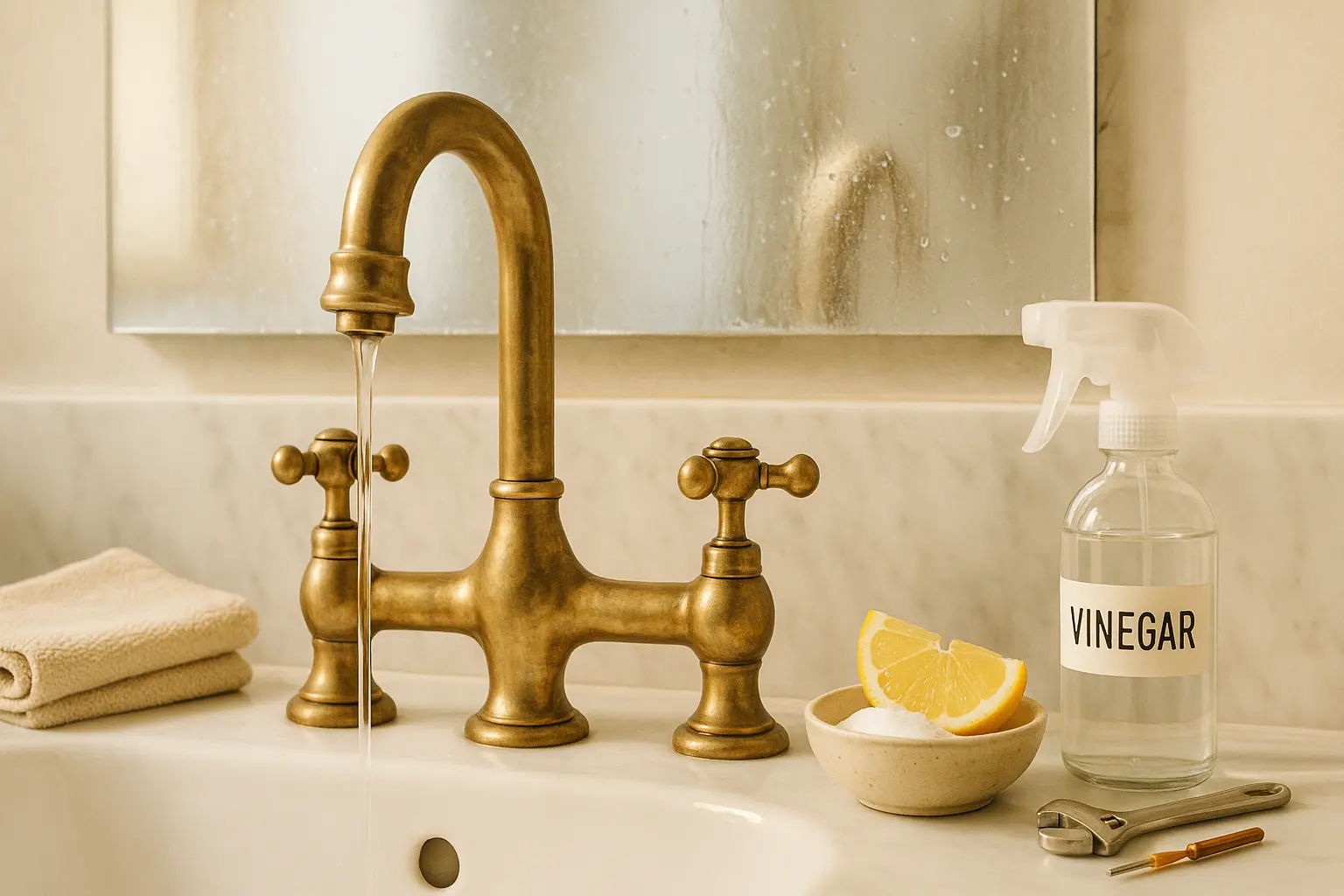
Essential Safety Features for Every Shower
Safety Features for Every Shower Shower safety is a top priority for a secure bathing environment. Falls are the leading


When investing in bathroom fixtures, it’s natural to ask: Do brass faucets rust? The short answer is no—brass bathroom faucets do not rust like iron or steel. But that doesn’t mean they’re immune to wear, discoloration, or tarnish over time.
Whether you’re considering a stylish bridge faucet or already own an unlacquered brass faucet, understanding how brass behaves, what causes surface damage, and how to prevent it will help protect your investment for years to come. In this guide, we’ll explore how brass responds to moisture, how to prevent unsightly changes, and why this timeless material remains a top choice for luxury bathrooms.
Brass is a metal alloy made primarily of copper and zinc. Unlike steel or iron—which are ferrous metals—brass is non-ferrous, meaning it contains no iron. Since rust is the result of iron oxidizing (reacting with water and oxygen), brass cannot rust in the traditional sense.
However, that doesn’t mean it’s invulnerable. Brass can:
If you’re asking “Do brass bathroom faucets rust?”, what you’re likely noticing is tarnish, which is a natural surface reaction—not structural damage. And for many, it’s part of the charm of owning unlacquered brass, which develops a unique patina over time.
Because while they don’t stay shiny forever without maintenance, brass bathroom faucets are prized for their:
For more insight into the material’s benefits, explore our guide on the Benefits of Brass Kitchen Faucets—many of which apply just as well in bathroom environments.
Preventing damage to brass bathroom faucets is simple with regular maintenance and a few preventative habits.
Water droplets, especially from hard water, leave mineral deposits behind. After each use, simply:
Use mild solutions to avoid damaging the finish. Avoid bleach, ammonia, or acid-based products.
Brass-safe cleaning options include:
For exact steps and product-safe tips, check out our trusted guide: How to Clean Brass with Household Products.
If you prefer to maintain a polished look (especially for polished or lacquered brass), consider applying a barrier:
Avoid steel wool, rough sponges, or magic erasers. These can scratch the finish and make the faucet more vulnerable to future discoloration.
If you love the vintage appeal of bridge faucets, you’re not limited to kitchen use. Many homeowners now install bridge-style brass bathroom faucets for a touch of luxury and timeless style.
These faucets pair beautifully with vessel sinks or marble countertops, and when made from brass, they offer the same durability and aesthetic as in the kitchen. For recommendations, explore our Best Bridge Faucets to find models that suit both bathroom and kitchen setups.
And if you’re planning an upgrade, don’t miss our Bridge Faucet Installation Guide—especially helpful for understanding compatibility with various surfaces and plumbing
systems.
Brass may not rust, but its appearance and performance can still be affected by the unique conditions found in bathrooms—especially high humidity, poor ventilation, and product buildup from soaps or cosmetics. Understanding these environmental impacts helps you take preventative steps beyond basic cleaning.
Bathrooms are typically warm, humid spaces with frequent exposure to water vapor and splashes. While brass is resistant to corrosion, long-term exposure to dampness can speed up oxidation (tarnishing) or cause water spots and mineral deposits.
Prevention tips:
If your home has hard water, it contains a high concentration of calcium and magnesium. Over time, these minerals leave white or greenish deposits on faucet surfaces and inside valves, affecting both aesthetics and functionality.
Signs of hard water damage on brass faucets:
Solutions:
Residues from hand soap, toothpaste, hairspray, or harsh cleaners can accumulate on your faucet, especially at the base or around handles. Many of these products contain alcohols or acids that can damage brass finishes over time.
What to avoid:
What to do instead:
Brass is less affected by oxygen than iron, but poor air circulation in bathrooms can trap airborne contaminants like moisture, sulfur compounds, and cleaning fumes—all of which can accelerate tarnishing.
Tip: Keep windows open when possible or use a ceiling fan to improve air exchange, especially in older homes with less modern ventilation.
If you’re using an unlacquered brass bathroom faucet, these environmental factors will influence how quickly the surface develops patina. Some homeowners welcome this change, while others prefer to preserve a brighter look. By controlling humidity, cleaning routinely, and minimizing product exposure, you can better manage how your faucet evolves over time.
Unlacquered brass is designed to change over time. This patina—a natural darkening of the surface—is highly sought after for its vintage charm. Many homeowners love how their faucet tells a story over time, with unique coloring and softness that lacquered finishes can’t replicate.
Patina is not rust. It’s a protective layer formed by natural oxidation that can actually prevent deeper corrosion. If you’re drawn to warm, lived-in finishes, embracing patina may be part of your aesthetic choice.
So, do brass faucets rust? Technically, no—brass cannot rust like iron. But it can tarnish or discolor if not properly cared for. With regular maintenance, smart cleaning habits, and a basic understanding of the material, your brass bathroom faucet can remain beautiful, functional, and full of character for decades.
Whether you’re maintaining a piece you love or exploring a luxurious upgrade, browse Insideast’s full collection of handcrafted brass faucets—including timeless unlacquered brass finishes that age gracefully and perform reliably in any bathroom.

Safety Features for Every Shower Shower safety is a top priority for a secure bathing environment. Falls are the leading
Receive your order to your door address anywhere in the world using our shipping partners
You're covered by our 30 days return policy
Big part of our reviews testifies about the quality of support provided
Secured payments using renowned payment gateways